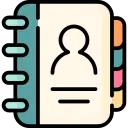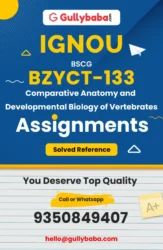IGNOU BZYET-143 Insect Vectors and Vector Borne Diseases - IGNOU Solved Assignment (Latest)
Get IGNOU BZYET-143 Assignments Soft Copy ready for Download in PDF for (January 2024 – December 2024) in English and Hindi Language.
- Helps save time and effort-really well
- Promises Good Marks in Less Time
- Answers that are verified and accurate
- Based on IGNOU Guidelines.
- Description
- Previous Year Solved Question Papers Included
- Assignments Details
- Assignment Submission End Date
- What's Included
PLEASE MATCH YOUR ASSIGNMENT QUESTIONS ACCORDING TO YOUR SESSION
IGNOU BZYET-143 (January 2025 – December 2025) Assignment Questions
1. Which structural, developmental and behavioristic characteristics make insects highly successful organisms on Earth? Explain.
2. Write short notes on the following:
i) Mouthpart modifications in insects
ii) Types of antennae in insects
iii) Leg modification in insects
iv) Typical structure of the wing
3. Discuss the reproduction and metamorphosis in insects.
4. Distinguish between the following insect orders based on the clue given in parentheses.
i) Mallophaga and Anoplura (Mouth parts)
ii) Heteroptera and Homoptera (Forewings)
iii) Diptera and Strepsiptera (Reduced wings)
iv) Isoptera and Hymenoptera (Joining of thorax and abdomen)
5. a) Explain vector-pathogen relationship.
b) Differentiate between:
i) Propagative Transmission and Cyclopropagative Transmission
ii) Cyclodevelopmental Transmission and Vertical Transmission
6. Name four insect orders which are of medical importance. Write at least one conspicuous feature and three examples of each order.
7. Explain the epidemiology of malarial parasite.
8. Draw a labeled diagram of:
a) Life cycle of Aedes mosquito
b) Dengue transmission Cycle
c) Zika Transmission Cycle
9. Write short notes on:
a) Traps used for controlling houseflies
b) Cultural control of Musca
c) Chemical control of housefly
d) Myiasis
10. a) Explain the concept of Integrated Vector Management.
b) How can the disease vectors be genetically manipulated to reduce their population?
IGNOU BZYET-143 (January 2024 – December 2024) Assignment Questions
1. i) Give two examples of insects for each of the following types of metamorphosis:
a) No metamorphosis: ………………………………………
b) Incomplete metamorphosis: ……………………………..
c) Complete metamorphosis: ……………………………….
ii) Give the different developmental stages in the following insects:
a) Silver fish: ………………………………………………..
b) Grass hopper: ……………………………………………
2. a) Differentiate between:
i) Propagative Transmission and Cyclopropagative Transmission
ii) Cyclodevelopmental Transmission and Vertical Transmission
b) Answer the following questions:
i) Name the reduced hindwings of diptera and write their functions.
ii) How do mosquitoes detect their host for sucking of blood?
3. a) Name a hemimetabolous order which is exclusively parasitic. Explain its morphological features in brief.
b) Write the important features of Order Siphonaptera which make them important disease vectors.
4. Write short notes on the following:
a) Prevention /control measures of fleas.
b) Typhus fever
c) Tunga penetrans
d) Yersinia pestis transmission
5. a) Distinguish between the following:
i) Pediculus humanus corporis and Pediculus humanus capitis
ii) Male and Female body louse
b) Explain the role of Reduviid bug as a biological vector in the transmission of Chagas disease.
6. a) Explain the epidemiology of malarial parasite.
b) Discuss the preventive and control measures of Anopheles mosquito.
7. Draw a labeled diagram of:
a) Life cycle of JE
b) Filarial worm transmission Cycle
8. Give difference between the following:
a) Extrinsic incubation period and intrinsic incubation period
b) Transverse and vertical transmission
c) Urban cycle and sylvatic cycle
9. Write short notes on:
a) Traps used for controlling houseflies
b) Cultural control of Musca
c) Chemical control of housefly
d) Myiasis
10. a) Explain the concept of Integrated Vector Management.
b) How can the disease vectors be genetically manipulated to reduce their population?
IGNOU BZYET-143 (January 2025 – December 2025) Assignment Questions
1. कौन सी संरचनात्मक, विकासात्मक और व्यवहारिक विशेषताएं कीटों को पृथ्वी पर अत्यधिक सफल जीव बनाती हैं? वर्णन कीजिए।
2. निम्नलिखित पर लघुटिप्पणी लिखिए :
i) कीटों में मुखांग रूपांतरण
ii) कीटों में एन्टिना के प्रकार
iii) कीटों में पैर के रूपांतरण
iv) पंखों की प्रारूपिक संरचना
3. कीटों में जनन और कार्यतरण के विषय में बताइए।
4. कोष्ठकों में दिए गए संकेतो के आधार पर निम्नलिखित कीट ऑर्डरो में भेद कीजिए।
i) मैलोफेगा और एनोप्लुरा (मुखांग)
ii) हिटरोप्टेरा और होमोप्टेरा (अग्रपंख)
iii) डिप्टेरा और स्ट्रेप्सिप्टेरा (लघुकृत पंख)
iv) आइसोप्टेरा और हाइमनोप्टेरा (वक्ष और उदर का जोड़)
5. क) वेक्टर-रोगजनक संबंध की व्याख्या कीजिए।
ख) निम्नलिखित के बीच अंतर लिखिए :
i) प्रवर्धी संचरण और चक्रवर्धी संचरण
ii) चक्र-विकासमूलक संचरण और लंबवत् ऊर्ध्वाधर संचरण
6. चार कीट ऑर्डरों के नाम बताइए जो चिकित्सकीय रूप से महत्त्वपूर्ण हैं। प्रत्येक ऑर्डर की कम से कम एक विशिष्ट विशेषता बताइए और तीन उदाहरण लिखें।
7. मलेरिया परजीवी की महामारी विज्ञान की व्याख्या करें।
8. निम्नलिखित का नामांकित चित्र बनाइए :
क) एडीज मच्छर का जीवन चक्र
ख) डेंगू संचरण चक्र
ग) जीका संचरण चक्र
9. निम्नलिखित पर संक्षिप्त टिप्पणियाँ लिखिए :
क) घरेलू मक्खियों के नियंत्रण में प्रयुक्त ट्रैप (पाश)
ख) मस्का का सस्य नियंत्रण
ग) घरेलू मक्खी का रासायनिक नियंत्रण
घ) माएसिस
10. क) एकीकृत वेक्टर प्रबंधन की अवधारणा का वर्णन कीजिए।
ख) रोग वेक्टर समष्टि को कम करने हेतु आनुवंशिक परिवर्तन कैसे किये जा सकते हैं?
IGNOU BZYET-143 (January 2024 – December 2024) Assignment Questions
1. i) निम्नलिखित किस्मों के कायांतरणों में से प्रत्येक के कीटों के दो उदाहरण दीजिए:
क) सिल्वर फिश ……………………………………………..
ख) टिड्डा ……………………………………………..
ग) तितली ……………………………………………..
ii) निम्नलिखित कीटों की विभिन्न परिवर्धनात्मक अवस्थाएँ लिखिए:
क) सिल्वर फ़िश ……………………………………………..
ख) टिड्डा ……………………………………………..
2. क) निम्नलिखित के बीच अंतर लिखिए:
i) प्रवर्धी संचरण और चक्रवर्धी संचरण
ii) चक्र – विकासमूलक संचरण और लंबवत् ऊर्ध्वाधर संचरण
ख) निम्नलिखित प्रश्नों के उत्तर दीजिए:
i) डिप्टेरा के लघुकृत पिछले पंखो का नाम बतायें और उनके कार्यों को लिखें।
ii) रक्त चूसने के लिए मच्छर अपने परपोषी का पता कैसे लगाते हैं?3.
3. क) एक हेमीमेटाबोलस ऑर्डर का नाम बताइए जो विशेष रूप से परजीवी है। संक्षेप में इसकी आकारिकीय विशेषताओं की व्याख्या कीजिए ।
ख) ऑर्डर साइफनाप्टेरा की महत्त्वपूर्ण विशेषताओं को लिखें जो उन्हें महत्त्वपूर्ण रोग वेक्टर बनाते हैं।
4. निम्नलिखित पर लघु टिप्पणी कीजिए :
i) पिस्सुओं की रोकथाम और नियंत्रण के उपाय
ii) टाइफस ज्वर
iii) टुंगा पेनीट्रेन्स
iv) मेर्सीनिया पेस्टिस संचरण
5. क) निम्नलिखित के बीच अंतर कीजिए:
i) पेडीकुलस हयूमेनस केर्पोरिस और पेडीकुलस हयूमेनस कैपीटिस
ii) नर और मादा देह जूंएं
ख) चगास रोग के संचरण में एक जैविक संवाहक (वेक्टर) के रूप में रेडुविड बग की भूमिका की व्याख्या करें।
6. क) मलेरिया परजीवी की महामारी विज्ञान की व्याख्या करें।
ख) ऐनोफेलीज़ मच्छर से बचाव और नियंत्रण के उपायों की चर्चा कीजिए ।
7. निम्नलिखित का नामांकित चित्र बनाइए
क) JE का जीवन चक्र
ख) फाइलेरिया कृमि संचरण चक्र
8. निम्नलिखित में अंतर लिखिए:
क) बाहरी ऊष्मायन अवधि और आंतरिक ऊष्मायन अवधि
ख) अनुप्रस्थ और ऊर्ध्वाधर संचरण
ग) शहरी चक्र और सिल्वेटिक चक्र
9. निम्नलिखित पर संक्षिप्त टिप्पणियाँ लिखिए:
क) घरेलू मक्खियों के नियंत्रण में प्रयुक्त ट्रैप (पाश)
(ख) मस्का का सस्य नियंत्रण
ग) घरेलू मक्खी का रासायनिक नियंत्रण
घ) माएसिस
10. क) एकीकृत वेक्टर प्रबंधन की अवधारणा का वर्णन कीजिए।
ख) रोग वेक्टर समष्टि को कम करने हेतु आनुवंशिक परिवर्तन कैसे किये जा सकते हैं?
BZYET-143 Assignments Details
| University | : | IGNOU (Indira Gandhi National Open University) |
| Title | : | Insect Vectors and Vector Borne Diseases |
| Language(s) | : | English, Hindi |
| Code | : | BZYET-143 |
| Degree | : | |
| Subject | : | Zoology |
| Course | : | Discipline Specific Electives (DSE) |
| Author | : | Gullybaba.com Panel |
| Publisher | : | Gullybaba Publishing House Pvt. Ltd. |










